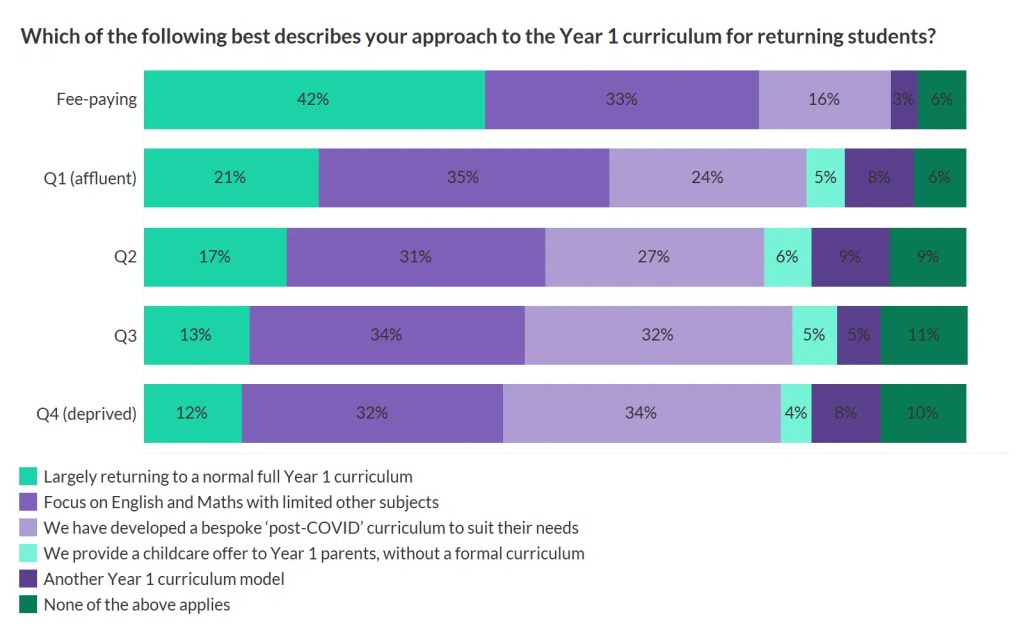1. Back to secondary school
Today marks the beginning of the re-opening of secondary schools to Years 10 and 12. However, this doesn’t mean that secondary teachers are back in school in large numbers. It seems that about a quarter of you will be in school on any given day.

Why such low numbers of secondary teachers in school? Years 10 and 12 are not returning to full-time education, but rather some very limited face-to-face contact. And it seems you are all doing this in very different ways.
We asked about your model for the return of Year 10 students. In the state sector, the most common model seemed to be students coming back for one day a week. But a very large percentage of you said you were doing something that wasn’t aligned to our options. A series of twitter conversations established that there seem to be about 3,000 different models for Year 10 return! We’ll be asking a few more questions to clarify what is going on this week.

Secondary schools are overwhelmingly using their in-person classroom lessons to focus on maths, English and science for Year 10. Less than a third of you are offering lessons for all option subjects. Some of you told us you were just having ‘EBacc’ lessons, for example.

Also, while one in three secondary schools are delivering classroom teaching in just the three core subjects on a typical returned day, many others are delivering anywhere between one and five lessons! It really is a mixed bag!

2. More on primary schools
Primary schools continued to re-open to Years R,1 and 6, albeit at very different rates across the regions. Some regions seem to be following government guidance more closely than others – the East of England and South West lead the way in most consistently prioritising younger year groups over Year 6.

Last week we reported that students from disadvantaged backgrounds were far less likely to be back in school because: (1) they live in regions less likely to have re-opened to more year groups; (2) within regions, more disadvantaged schools were less likely to re-open; (3) even when re-opened, disadvantaged schools were reporting poorer return rates.
We have more bad news for inequalities this week. For those schools who re-opened first, the proportion of students in school has increased. However, it hasn’t served to close the gaps in attendance since the attendance improvements were greatest in the more affluent schools.

Even worse, teachers have reported that pupil premium students are more likely to be staying at home than other students.

Is it business as normal for Year 1 students now? In terms of the curriculum, it is for 4-in-10 teachers at fee-paying schools and for 1-in-5 at affluent schools. However, most state-schools are provided an adapted curriculum and for a third this means largely focusing on English and maths.

Of course, whilst some primary students are back, the majority of year groups are having to stay at home. The government warned that provision for them would decline, so we wanted to know the extent to which you felt the support they were receiving had fallen. Strangely, three-quarters of you said that provision is still exactly the same for Years 2-5, despite the classroom teachers now teaching another year group for at least 4 days a week. How can this be? Do let us know.

The government’s plan to get Years R,1 and 6 back in (close-to) full-time doesn’t seem so smart now that it’s clear schools will struggle to get other year groups to join them. We asked what sort of arrangements you’d like to see for the last four weeks of term. Most classroom teachers opted for every year group in a rota of on-a-week, off-a-week rota, with continuing provision for key workers. Headteachers also opted for this, but were a bit less keen – they are the ones who have to try and work out how on earth you’d actually fit all the children in the school this way!

3. A little less uniform
School uniforms are not well suited to a pandemic. Secondary pupils tend only to have one blazer and tie which cannot be easily washed on arrival at home each day, should parents want to. Primary pupils – especially girls – tend to wear clothes and shoes that are poorly suited to games outside, and teachers can no longer physically help them change.

Two-thirds of primary schools are planning to fix the PE changing issue, either by allowing any clothes to be worn, or by allowing trainers at all times, or by keeping PE kit on all day.

For schools with blazers, one-third said students would wear no uniform at all in June and July and a further quarter told us that blazers would not be required. However, that still leaves about 4-in-10 who will still have to wear their blazer when they attend school. (Given how infrequently most Year 10s are attending, perhaps this is not an issue.)

4. What will happen in September?
The closer we edge to September, the more pessimistic teachers get about the possibility of returning to full-time schooling. A month ago, 35% of teachers felt this was unlikely; yesterday this figure had grown to 51%.

It isn’t all bad news though. A month ago, just 26% of school leaders felt they would be able to have 90% of their teaching staff working in school. Last week, this figure had grown massively to 47%.

Time for the tips…
- Why do children idolise some celebrities and ignore others?
- Elaborative Diacope
- The KS2 reading curriculum
- What will change in education and what will stay the same?
- Maths – Reasoning, Problem Solving, Fluency
- Teaching procedural knowledge
- Changing classroom culture
- Schools are actually quite inefficient
- Repetition and learning





